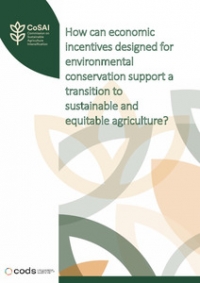
Bees, wasps, and hornets don’t always get along with humans. Their stings are extremely painful and kill about 58 people per year. But as we pointed out in our Thrive Blog Big Question: Give Bees a Chance, these yellow and black arthropods offer vital ecosystem services by means of pollination and pest control; by 2009, the values of pollination-dependent crops in America reached $15.12 billion.
Over the past 20 years, bee, wasp, and hornet populations have been threatened by climate change and poor farming practices. Harvard University is working on autonomous flying microrobots (RoboBees) in an attempt to replicate the vital ecosystem services that they provide, but their efforts might be expensive and take years to develop. While RoboBees may provide an enticing solution to the problem of pollination itself, they don’t get at the core of the problem: collapsing pollinator populations are a sign that agro-ecological practices need to change.
To intensify or not to intensify?
A more promising solution might be the implementation of agroecological intensification (AEI), a management approach that integrates ecological principles and biodiversity management into farming systems. In areas of China where there are diverse crops and land uses, it was found that farmers can save US$4.96 on pesticides for each additional cotton-aphid-consuming ladybeetle per 100 cotton plants. The ultimate goal of AEI is to increase farm productivity, reduce dependency on external inputs, and sustain or enhance ecosystem services such as pest control, pollination, soil fertility, and water purification.
But how well does agroecological intensification stack up against conventional high-input, high-technology farming systems? Is it possible to make environmentally sustainable farming profitable enough to convince farmers to hop on board the AEI train?
Some previous research suggests that the yield of agroecological systems is greater than or equal to un-intensified ones, while other studies point to decreased production, particularly in organic farming. However, by focusing exclusively on yield, the research discounts the contributions of ecosystem services environmentally and financially. There have been few systematic evaluations of AEI systems that consider outcomes for both ecosystem services and yield—until now.
Putting the "func" in multi-functional
A recently-published, WLE-funded paper in the International Journal of Agricultural Sustainability provides a valuable meta-analysis of over 100 studies containing 245 individual comparisons between AEI and contrasting farming systems. It quantitatively measured the synergies and trade-offs of nine on- and off-farm ecosystem services across five AEI systems. In three of the five AEI systems, more than half of the reviewed comparisons reported ‘win-win’ outcomes, enhancement of both yield and ecosystem services, or ‘win-neutral’ outcomes relative to conventional farming systems.
But what about the other two AEI systems? The results suggest that in the cases of holistic grazing management and organic agriculture, there are either neutral or negative outcomes for yield and ecosystem services. Tradeoffs exist where increasing yield means reducing the amount of ecosystem services that are rendered, or vice versa. Although there is substantial evidence that the five AEI systems can increase ecosystem service provision or reduce negative agricultural externalities while maintaining or increasing yields, that is not necessarily true in every context: Garbach et al. only looked at five AEI systems and nine ecosystem services. Such broad multi-functionality has simply not been well-studied, and no one knows whether suites of desirable ecosystem services benefitting both on-site farmers and off-site beneficiaries respond in similar directions under shifts to AEI management.
Off-site friends who benefit
Land managers and policymakers will need longer-term quantitative measures of yield levels and ecosystem service benefits in order to make more informed decisions. A system’s benefits may not manifest for up to 10 years, whereas more mainstream intensive farming practices can be productive in the short term but harmful in the long term, such as fertilizers that increase nitrogen availability to crops but progressively deplete the nutrients of soil organic matter (SOM). For farmers, it’s easy to understand and profit from on-site ecosystem services such as pest control, pollination, soil fertility enhancement, and weed control. Going forward, it will be important to recognize the role that agricultural land managers play in providing critical ecosystem services that benefit users well beyond farm boundaries. These “off-site benefits” support broader public goods, including biodiversity and habitat provision, carbon sequestration, erosion control, water flow regulation, and water purification.
Garbach et al.’s meta-analysis provides an analytic framework to critically assess the multi-functionality of agricultural systems. If, however, the bottom line for farmers is crop yield, then the framework carries the potential to discourage investment in agroecological intensification. An increased public pressure to reduce environmental damage of agriculture may help foster policy support for certification systems, payments for ecosystem services, or government incentives for agricultural management that increases delivery of ecosystem services.
Why re-invent the wheel? Similarly, why spend time and money to replicate the ecosystem services that Mother Nature has honed for billions of years? Agroecological intensification, when properly quantified and applied, can save two birds with one stone by improving yield for land managers and protecting ecosystem services that benefit those both on and off the farm. This could be a way to meaningfully start addressing the growing needs for food production for our burgeoning population without negatively impacting the environment.
One of the final steps to establishing effective and long-lasting agroecological solutions will be involving and learning from indigenous peoples and smallholder farmers themselves. The Stakeholder Engagement Strategy under the Intergovernmental Panel on Biodiversity and Ecosystem Services (IPBES) aims to strengthen the science-knowledge-policy interface of this important issue. Since the inception of IPBES in 2012, WLE scientists have been directly involved in the regional assessment for Africa and the thematic assessment on land degradation. The Stakeholder Engagement Strategy, in addition to behavioral games in Cambodia, can serve as a model for understanding how different groups use and value biodiversity and its benefits. The success of AEI begins and ends with the farmers themselves, who hold the fate of humanity and the honeybee in their hands.




















